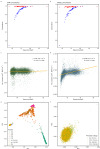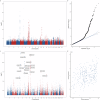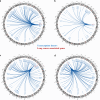Non-coding genetic elements of lung cancer identified using whole genome sequencing in 13,722 Chinese
- PMID: 40783572
- PMCID: PMC12335547
- DOI: 10.1038/s41467-025-62459-6
Non-coding genetic elements of lung cancer identified using whole genome sequencing in 13,722 Chinese
Abstract
A substantial portion of lung cancer-associated genetic elements in East Asian populations remains unidentified, underscoring the need for large-scale genome-wide studies, particularly on non-coding regulation. We conducted a whole genome sequencing (WGS)-based genome-wide scan in 13,722 Chinese individuals to identify regulatory elements associated with lung cancer. We verified common-variant-based loci by meta-analysis across the available East Asian studies. Integrating a genome-transcriptome reference panel of lung tissue in 297 Chinese, we bridged the variant-lung cancer associations, highlighting genes including TP63 and DCBLD1. Implementing the STAAR pipeline for rare variant aggregate analysis, we identified and replicated novel genes, including PARPBP, PLA2G4C, and RITA1 in the context of non-coding regulation. Adapting a deep learning-based approach, potential upstream regulators such as TP53, MYC, ZEB1, and NFKB1 were revealed for the lung cancer-associated genes. These findings offered crucial insights into the non-coding regulation for the etiology of lung cancer, providing additional potential targets for intervention.
© 2025. The Author(s).
Conflict of interest statement
Competing interests: The authors declare no competing interests.
Figures






References
-
- Sung, H. et al. Global cancer statistics 2020: GLOBOCAN estimates of incidence and mortality worldwide for 36 cancers in 185 countries. CA Cancer J. Clin.71, 209–249 (2021). - PubMed
MeSH terms
Substances
Supplementary concepts
LinkOut - more resources
Full Text Sources
Medical
Research Materials
Miscellaneous

